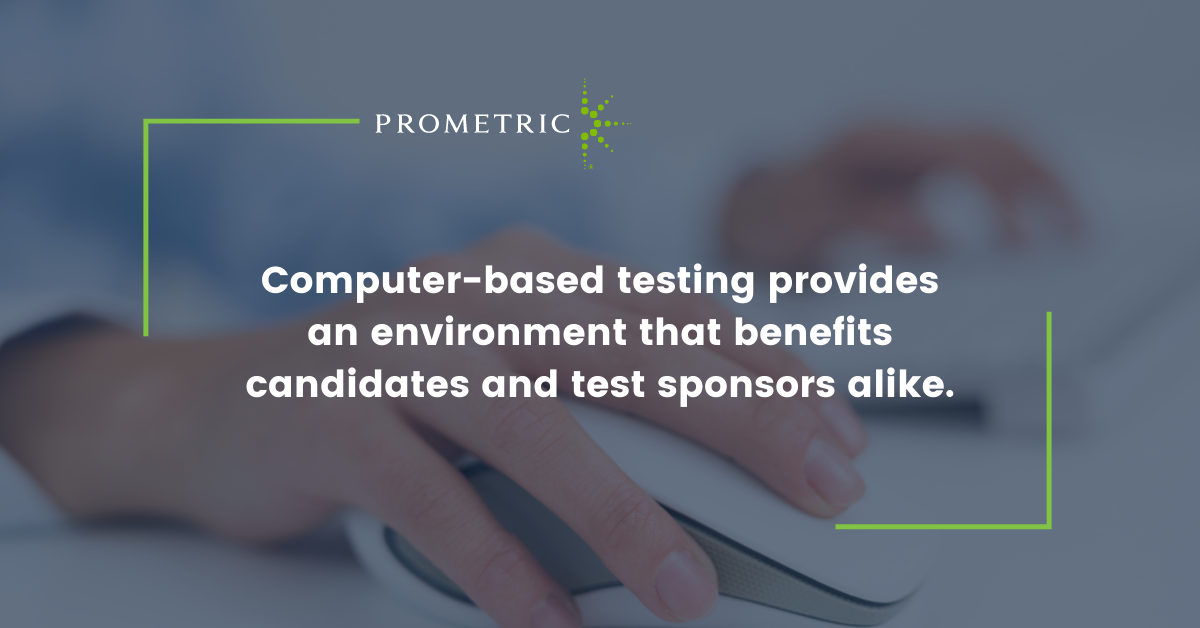When considering test delivery options, many organizations have adopted computer-based testing (CBT) to offer secure exam delivery and an improved candidate experience.
Computer-based testing is an efficient way for test sponsors to provide a consistent environment for certification and licensure examinations, while also offering many benefits to candidates.
It is common for testing volumes to increase after a full conversion from paper-based testing (PBT) to CBT, often as a result of the availability of a greater number of testing locations and more flexible scheduling and testing opportunities.
Migration from PBT to CBT does affect candidate behavior, however, and it is possible for some testing programs to experience brief reductions in demand triggered by candidate apprehension regarding CBT. This sometimes results in either a last-minute increase in testing during final PBT administrations or candidate procrastination to the last available computerized testing date.
Therefore, the question facing licensing organizations is how to keep test volumes up and candidate uncertainty down when migrating from a paper-based to a computer-based test?
The key to mitigating test volume risk and ultimately driving an increase in demand is ongoing marketing, candidate education, and outreach. In terms of promoting the new computerized testing program, marketing and effective communication can have an important impact on stakeholder acceptance of CBT and comfort with its use.
In order to allay candidate fears and minimize questions, it is prudent to launch a communications campaign early in the conversion process that directly addresses constituent concerns and promotes sustainable program interest.

Types of Candidate Outreach
Some of the more commonly utilized and effective candidate communication outreach initiatives include:
Educational presentations: Educational presentations should focus on information regarding the benefits of CBT for testing candidates. They may present information on new content areas, changes in test structure or format, system navigation, and other program changes (e.g. test duration, question review, break policies). They may also give candidates a glimpse of the new "look and feel" of the test. Presentations or demonstrations may be given at conferences, user group meetings or other relevant forums, as well as via other mediums such as a web conference.
Written material: Written material may take the form of articles, white papers, or other material that discuss the reasons for migration to CBT and the benefits for candidates. Colorful sheets containing visual "snapshots" can pictorially explain to candidates how to navigate a computer-based test. Effective materials focus on core ideas and topics and present information in a concise format that is easily understood by the individual.
Public relations campaign: A targeted public relations program will strive to promote the value of computer-based delivery and benefits to candidates, such as same-day exam scoring, improved security, or on-demand scheduling. The campaign may include media relations, speaking opportunities, and special events components.
Website campaign: A website campaign may include a webcast explaining and demonstrating any differences between paper-based and computer-based testing. It could walk candidates through a sample CBT, showing them where and how to navigate through the exam and familiarizing them with the layout and content. The campaign may also include a tutorial on new operational procedures associated with the CBT program, including registration and scheduling processes and site administration policies.

A "Test Drive" tutorial: Prometric's Test Drive provides candidates with a real world, end-to-end practice run before the date of their scheduled test. In 30 minutes, the candidate will experience a complete run through of the testing experience they will encounter on their actual testing day. During the Test Drive, the candidate will: experience the scheduling and registration process, walk through the site check-in procedures, meet the test center staff, familiarize themselves with the physical location and environment at the test center, and sit for a live 15-minute sample test with generic content. The goal of this program is to familiarize candidates of certain types of testing programs with the end-to-end CBT testing process prior to the day of administration, allowing the candidate to focus all of their attention on demonstrating mastery of the subject matter of the test.
Testimonials: Testimonials and "lessons learned" from other candidates who've already had the experience can be passed along to promote the benefits of the new test from candidate, partner or administrator perspectives.
Post-test feedback survey: A post-launch survey of test-takers can be used to improve future versions of the test and associated test administration processes. The survey can be executed via the Internet immediately following the test, via telephone or mail or via test candidate focus groups. Candidates may provide feedback on any of the following: registration, scheduling, site administration, security, content, navigation, functionality, score reporting, fees and overall satisfaction.
Taking any or all of these steps to reach out to candidates in advance of a newly computerized test is critical to easing the transition. The main goal of each of the initiatives above is to keep candidates informed. Without candidate education, awareness, and ultimate buy-in, candidates may refuse to test or delay testing, impacting testing volumes and, ultimately, revenues.
Frequent communication with the candidate base is essential when migrating from PBT to CBT.
Common Topics of Interest to Testing Candidates
In the absence of information, anxiety regarding the new delivery methodology may increase and impact candidate behavior. Providing answers to questions, even those that may appear on the surface to be basic or simple, helps candidates feel comfortable accepting CBT.
Some content worth sharing includes:
- Candidate experience improvements
- More convenient test options
- Increased test availability
- Options for testing locations
- Intuitive test-taking tools
- More engaging and realistic question types
- Real time feedback and same day scoring options
- New technologies that create better outcomes for test takers
- Accessibility features and other measures to provide equitable testing
- How assistive devices and technology are incorporated into testing
- Support for additional languages
- Options for test adaptations
- Standard frequently asked questions
- How the new test is similar and different from what candidates are familiar with
- Where tests can be taken (remote, in-center, or both)
- Details on what to expect during the testing experience
- What kind of security to expect
- How live and virtual proctoring work
- Reassurance about the exam format
- Information about the testing platform
- Contact information for person-to-person questions and support
Remain Focused on Your Candidates
Ultimately, educating candidates and making their experiences as positive as possible will drive volume and success for the testing program. Organizations can undertake a number of initiatives, in isolation or in combination, to generate interest in and support of candidates. With the aid of a good communications plan and an understanding of what your stakeholders need, the process should be straightforward. In many cases, a testing partner can assist as well, leveraging their experience to help make the adoption process a smooth one.
As long as you’re committed to open communication with your candidates, moving to computer-based testing will present your organization with opportunities for growth and increased candidate satisfaction.
